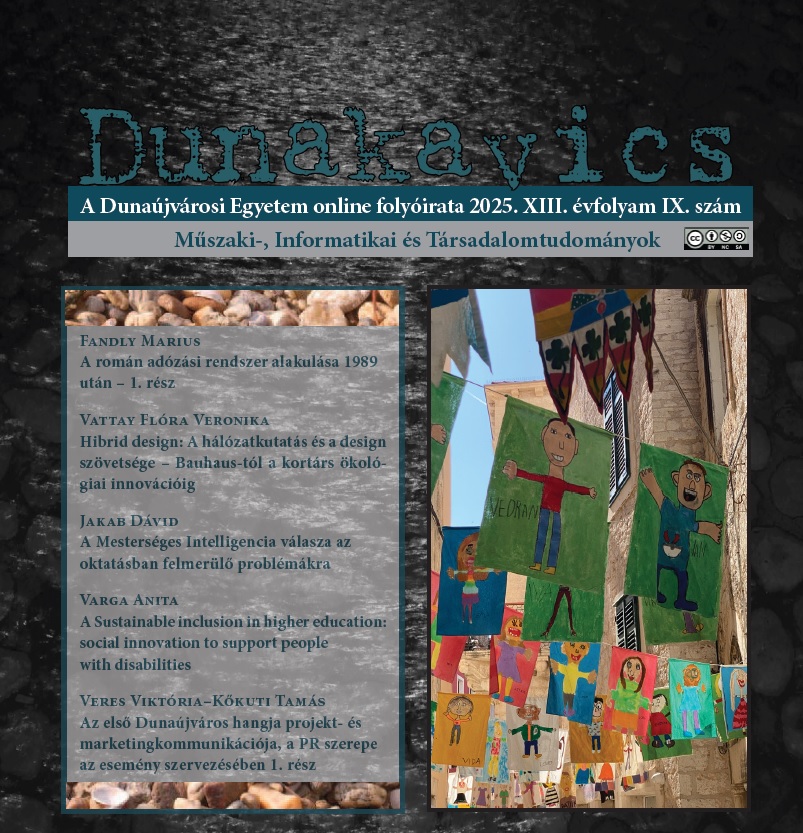Hibrid design: A hálózatkutatás és a design szövetsége – Bauhaustól a kortárs ökológiai innovációig
Abstract
This study examines the contemporary paradigm of hybrid design, a design approach that simultaneously draws on the knowledge of art, science, technology, and ecology, aiming at their sustainable integration. The essence of hybrid design is not merely the creation of objects, but the reorganization of complex ecosystems, social and natural relations, and the establishment of new dynamics. Within this framework, the designer is not only making aesthetic decisions but acts as a mediator, a network bridge: capable of connecting engineers with biologists, social scientists with computer experts, artists with industrial partners. In this process, network research is not only a theoretical background but a universal design toolkit, offering a shared conceptual language for the unified modeling and coordinated transformation of diverse domains and heterogeneous systems (materials, processes, communities, technologies). The historical trajectory (Bauhaus–MIT) demonstrates how the network logic of interdisciplinarity became institutionalized, while contemporary case studies (Neri Oxman’s material ecology, Tomás Saraceno’s spiderweb-based installations, Michael Strano’s bioluminescent plants) illustrate the metaphorical, analytical, and operative applications of network thinking in design practice. We highlight that scale-free, small-world, and multiplex network models in hybrid design enable the identification of key actors, the acceleration of knowledge flow, and the layering of collaborations. Our conclusion is that the potential expansion of hybrid design as a discipline lies in the alliance of network science and design, which enhances transparency, flexibility, innovation potential, and sustainability in design, while simultaneously offering a renewed, structured role for the arts.
References
Adamatzky, A., & Saraceno, T. (2020). Spider/web communication in biohybrid networks. Leonardo, 53(2), 212–219. https://doi.org/10.1162/leon_a_01830
Barabási, A.-L. (2002). Behálózva: A hálózatok új tudománya (ford. Bognár Róbert). Budapest: Magyar Könyvklub.
Barabási, A.-L. (2013). Villanások: A jövő kiszámítható (ford. Török Gábor). Budapest: Libri.
Barabási, A.-L. (2016). A képlet: A siker egyetemes törvényei (ford. Török Gábor). Budapest: Libri.
Barabási, A.-L., & Albert, R. (1999). Emergence of scaling in random networks. Science, 286(5439), 509–512. https://doi.org/10.1126/science.286.5439.509
Burt, R. S. (1992). Structural holes: The social structure of competition. Cambridge, MA: Harvard University Press.
Colani, L. (2019). Hybrid design: Interdisciplinary approaches in contemporary practice. London: Routledge.
Droste, M. (2002). Bauhaus 1919–1933. Köln: Taschen.
Erdős, P., & Rényi, A. (1959). On random graphs I. Publicationes Mathematicae, 6, 290–297.
Euler, L. (1736). Solutio problematis ad geometriam situs pertinentis. Commentarii Academiae Scientiarum Imperialis Petropolitanae, 8, 128–140.
Granovetter, M. S. (1973). The strength of weak ties. American Journal of Sociology, 78(6), 1360–1380. https://doi.org/10.1086/225469
Kennedy, S. (2018). Design as a form of brokerage: Mediating science and society through material innovation. Journal of Architectural Education, 72(1), 24–33. https://doi.org/10.1080/10464883.2018.1407956
Kepes, G. (1965). The new landscape in art and science. Chicago: Paul Theobald.
Kepes, G. (1979). A vizuális kommunikáció. Budapest: Gondolat.
Kivelä, M., Arenas, A., Barthelemy, M., Gleeson, J. P., Moreno, Y., & Porter, M. A. (2014). Multilayer networks. Journal of Complex Networks, 2(3), 203–271. https://doi.org/10.1093/comnet/cnu016
Kwak, S. Y., Giraldo, J. P., Lew, T. T. S., Wong, M. H., Liu, P., Yang, Y., ... & Strano, M. S. (2017). A nanobionic light-emitting plant. Nano Letters, 17(12), 7951–7961. https://doi.org/10.1021/acs.nanolett.7b04369
Manzini, E. (2015). Design, when everybody designs: An introduction to design for social innovation. Cambridge, MA: MIT Press.
Moholy-Nagy, L. (1947). Vision in motion. Chicago: Paul Theobald.
Moholy-Nagy, L. (2010). Látás mozgásban (válogatott írások; ford. Forgács Éva). Budapest: Typotex.
Negroponte, N. (1995). Being digital. New York: Alfred A. Knopf.
Negroponte, N. (1997). Digitális létezés (ford. Mátis Lívia). Budapest: Typotex.
Newman, M. E. J. (2010). Networks: An introduction. Oxford: Oxford University Press.
Oxman, N. (2010). Material-based design computation. MIT Design Issues, 26(1), 78–92. https://doi.org/10.1162/desi.2010.26.1.78
Oxman, N., & csapata. (2014). Silk Pavilion: A biologically inspired digital fabrication project. MIT Media Lab Research Report.
Saraceno, T. (2012). Cloud Cities. Berlin: Hamburger Bahnhof.
Watts, D. J. (2004). Six degrees: The science of a connected age. New York: W. W. Norton.
Watts, D. J., & Strogatz, S. H. (1998). Collective dynamics of ‘small-world’ networks. Nature, 393(6684), 440–442. https://doi.org/10.1038/30918

This work is licensed under a Creative Commons Attribution-NonCommercial-ShareAlike 4.0 International License.




